初中英语语法大全之句子的种类
初中英语语法之句子种类
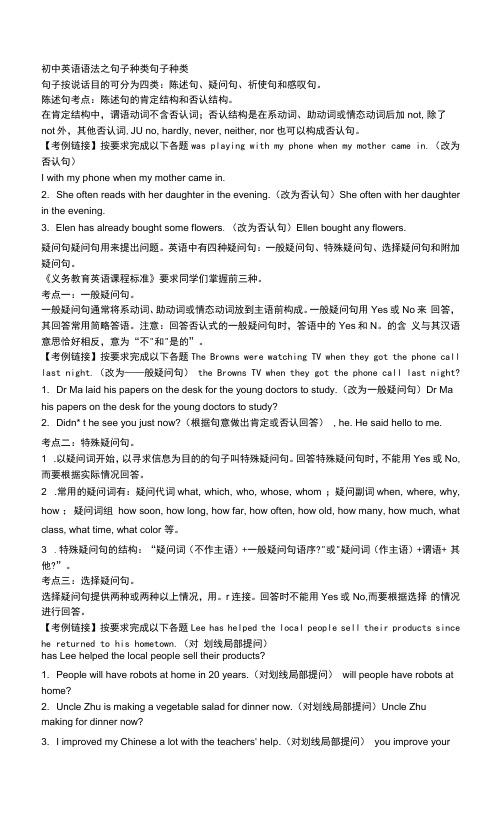
初中英语语法之句子种类句子种类句子按说话目的可分为四类:陈述句、疑问句、祈使句和感叹句。
陈述句考点:陈述句的肯定结构和否认结构。
在肯定结构中,谓语动词不含否认词;否认结构是在系动词、助动词或情态动词后加not, 除了not外,其他否认词,JU no, hardly, never, neither, nor也可以构成否认句。
【考例链接】按要求完成以下各题was playing with my phone when my mother came in.(改为否认句)I with my phone when my mother came in.2. She often reads with her daughter in the evening.(改为否认句)She often with her daughter in the evening.3. Elen has already bought some flowers.(改为否认句)Ellen bought any flowers.疑问句疑问句用来提出问题。
英语中有四种疑问句:一般疑问句、特殊疑问句、选择疑问句和附加疑问句。
《义务教育英语课程标准》要求同学们掌握前三种。
考点一:一般疑问句。
一般疑问句通常将系动词、助动词或情态动词放到主语前构成。
一般疑问句用Yes或No来回答,其回答常用简略答语。
注意:回答否认式的一般疑问句时,答语中的Yes和N。
的含义与其汉语意思恰好相反,意为“不"和"是的”。
【考例链接】按要求完成以下各题The Browns were watching TV when they got the phone call last night.(改为——般疑问句) the Browns TV when they got the phone call last night?1. Dr Ma laid his papers on the desk for the young doctors to study.(改为一般疑问句)Dr Ma his papers on the desk for the young doctors to study?2. Didn* t he see you just now?(根据句意做出肯定或否认回答), he. He said hello to me.考点二:特殊疑问句。
中考英语语法总复习:五大句子句型种类

中考英语语法总复习:五大句子句型种类英语句子按照使用目的和交际功能分为陈述句、疑问句、祈使句、感叹句和There be句型。
英语句子按照其结构分为简单句、并列句、复合句和并列复合句。
一、陈述句陈述句用来叙述一件事情或表明说话人的看法、态度等,句末用“.”,一般读作降调。
包括肯定陈述句和否定陈述句。
陈述句的语序一般为“主语部分+谓语部分”。
(一)陈述句的肯定形式陈述句的肯定形式分为两种,一种为正常语序,一种为倒装语序。
例句:Here comes the bus !公共汽车来了!例句:On the top of the mountain stands an old pine tree.山顶上长着一颗古松。
例句:We all felt excited when China succeeded in launching its first manned spaceship.当中国载人宇宙飞船发射成功后我们无比兴奋。
例句:If one has no greed and arrogance about life,nor does he have scare and timidness about death;one will not worry about death while living,nor will he yearn for life while dying.对生不会贪求与狂妄,对死也不会害怕与胆怯;于是生时不虑死,死时不恋生。
(二)陈述句的否定形式1)如果句子的谓语为be,have,can,could等,其否定形式便是在这些之后加not例句:Personality is the key. The man of grand personality is not afraid of loneliness.Every sublime creative artist and inventor has valued loneliness.个性是关键。
初中英语语法大全句子种类

初中英语语法大全-句子的种类按照英语句子的使用目的和用途,句子可分为四类:陈述句(Declarative Sentence)、疑问句(Interrogative Sentence)、祈使句(Imperative Sentence)和感叹句(Exclamatory Sentence)。
陈述句包括肯定陈述句和否定陈述句。
疑问句有一般疑问句、特殊疑问句、选择疑问句和反意疑问句。
图解语法1. 陈述句说明一个事实或陈述一个人的看法,陈述句包括肯定陈述句和否定陈述句特别提示:肯定陈述句改成否定句或一般疑问句时,如句中有already,some,something,somebody等词,须分别改成yet,any,anything,anybody等。
另外,也要注意,too改成either,both改成neither,all改成none等。
2. 疑问句3. 常用的特殊疑问句4. 特殊的反意疑问句①主句是祈使句时,“will you”意为“请求”,“won’t you”表示提醒对方注意。
例句:Look at the blackboard, will you / won’t youDon’t be late again, will you②感叹句后的反意疑问,用一般现在时态的否定形式例句:What fine weather, isn’t itHow beautifully she sings, doesn’t she③陈述部分是“I am …”时,用“aren’t I”而不用“am not I”例句:I'm working now, aren’t I④陈述部分主语是everything,nothing,anything或something 时,疑问句主语用it例句:Something is wrong with my radio, isn’t itNothing is difficult, is it⑤陈述部分的主语是somebody, nobody, everybody, anybody, no one,none, neither 时,疑问句的主语用they例句:Everyone is here, aren’t theyNo one knows about it, do they⑥陈述部分的主语是:1) this或that时,问句的主语用it2) these或those时,问句主语用they3) there be句时,反意疑问句中用there例句:This is a plane, isn’t itThese are grapes, aren’t theyThere was a hospital here, wasn’t there⑦陈述部分的主语是one时,问句的主语可用one,也可用you (美语用he)例句:One should be ready to help others, shouldn’t one⑧陈述句中有few, seldom, never hardly,not,rarely,no,nobody,too…to等时,疑问句部分用肯定结构;如由前后缀构成否定词,疑问句部分仍用否定结构例句:He is never late for school, is heYou got nothing from him, did youIt is useless, isn’t it⑨陈述部分主语是从句、不定式(短语)、动词-ing形式时,疑问句的主语用it例句:What you need is more important, isn’t it⑩陈述部分由think, believe, suppose, imagine等引导的宾语从句:1) 主语是第一人称时,问句与从句的主谓语一致2) 主语是其他人称,问句与主句的主谓语一致例句:I think he will come, won’t heI don’t think he can pass the exam, can heHe believed you had seen her before, didn’t hehave是实义动词时,疑问句用助动词do,does,did;have 是助动词,则不然例如:They had a meeting just now, didn’t theyShe’s been to many places of interest, hasn’t she陈述部分有have /has /had to 时,疑问句要用助动词的否定形式例句:You have to water the vegetables now, don’t you陈述部分有had better时,疑问句中用hadn’t刘局:We had better go to school at once, hadn’t we陈述部分有must:1) 作“一定;必须”解释时,疑问句用mustn’t或needn’t;2) 表示推测,作“一定是;必定”解释时,疑问句需根据其后的动词原形选用相应的形式;3) 对过去动作推测时,问句的助动词用did或have;4) 对过去的状态推测时,问句的be用was例句:He must work hard at physics, mustn’t heYou must go to Guangzhou, needn’t youYou mustn’t smoke here, must youTom must be at home, isn’t heShe must have finished her work, hasn’t/didn’t sheHe must have been a policeman, wasn’t he陈述部分有ought to,used to,疑问句要用 shouldn’t,usedn’t / didn’t例句:Jill used to be a teacher, usedn’t / didn’t she陈述句部分是复合句时,疑问句的主语和助动词要与主句一致例句:He was reading when the teacher came in, wasn’t he特别提示:反意疑问句是“否定陈述句+肯定问句”时,如回答内容是肯定的,用“Yes+肯定结构”,反之,用“No+否定结构”。
英语中的句子成分语法知识:初中英语语法大全
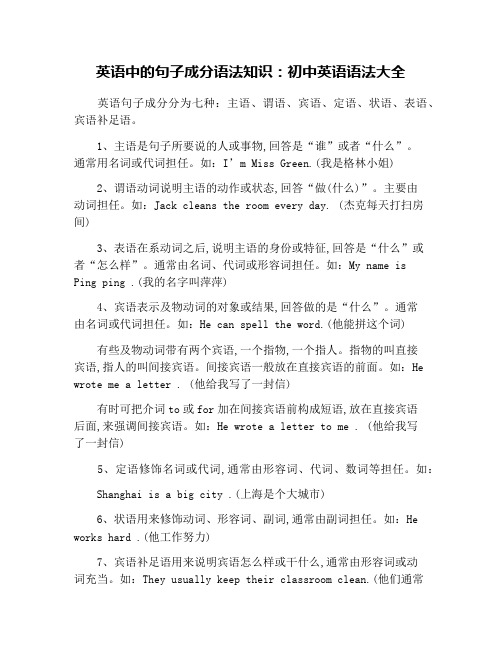
英语中的句子成分语法知识:初中英语语法大全英语句子成分分为七种:主语、谓语、宾语、定语、状语、表语、宾语补足语。
1、主语是句子所要说的人或事物,回答是“谁”或者“什么”。
通常用名词或代词担任。
如:I’m Miss Green.(我是格林小姐)2、谓语动词说明主语的动作或状态,回答“做(什么)”。
主要由动词担任。
如:Jack cleans the room every day. (杰克每天打扫房间)3、表语在系动词之后,说明主语的身份或特征,回答是“什么”或者“怎么样”。
通常由名词、代词或形容词担任。
如:My name isPing ping .(我的名字叫萍萍)4、宾语表示及物动词的对象或结果,回答做的是“什么”。
通常由名词或代词担任。
如:He can spell the word.(他能拼这个词)有些及物动词带有两个宾语,一个指物,一个指人。
指物的叫直接宾语,指人的叫间接宾语。
间接宾语一般放在直接宾语的前面。
如:He wrote me a letter . (他给我写了一封信)有时可把介词to或for加在间接宾语前构成短语,放在直接宾语后面,来强调间接宾语。
如:He wrote a letter to me . (他给我写了一封信)5、定语修饰名词或代词,通常由形容词、代词、数词等担任。
如:Shanghai is a big city .(上海是个大城市)6、状语用来修饰动词、形容词、副词,通常由副词担任。
如:He works hard .(他工作努力)7、宾语补足语用来说明宾语怎么样或干什么,通常由形容词或动词充当。
如:They usually keep their classroom clean.(他们通常让教室保持清洁) / He often helps me do my lessons.(他常常帮我做功课) / The teacher wanted me to learn French all by myself.(老师要我自学法语)。
初中英语语法大全-句子种类

初中英语语法大全-句子的种类按照英语句子的使用目的和用途,句子可分为四类:陈述句(Declarative Sentence)、疑问句(Interrogative Sentence)、祈使句(Imperative Sentence)和感叹句(Exclamatory Sentence)。
陈述句包括肯定陈述句和否定陈述句。
疑问句有一般疑问句、特殊疑问句、选择疑问句和反意疑问句。
图解语法1. 陈述句说明一个事实或陈述一个人的看法,陈述句包括肯定陈述句和否定陈述句特别提示:肯定陈述句改成否定句或一般疑问句时,如句中有already,some,something,somebody等词,须分别改成yet,any,anything,anybody等。
另外,也要注意,too改成either,both改成neither,all改成none等。
2. 疑问句3. 常用的特殊疑问句4. 特殊的反意疑问句①主句是祈使句时,“will you?”意为“请求”,“won’t you?”表示提醒对方注意。
例句:Look at the blackboard, will you / won’t you?Don’t be late again, will you?②感叹句后的反意疑问,用一般现在时态的否定形式例句:What fine weather, isn’t it?How beautifully she sings, doesn’t she?③陈述部分是“I am …”时,用“aren’t I?”而不用“am not I?”例句:I'm working now, aren’t I?④陈述部分主语是everything,nothing,anything或something 时,疑问句主语用it例句:Something is wrong with my radio, isn’t it?Nothing is difficult, is it?⑤陈述部分的主语是somebody, nobody, everybody, anybody, no one,none, neither 时,疑问句的主语用they例句:Everyone is here, aren’t they?No one knows about it, do they?⑥陈述部分的主语是:1) this或that时,问句的主语用it2) these或those时,问句主语用they3) there be句时,反意疑问句中用there例句:This is a plane, isn’t it?These are grapes, aren’t they?There was a hospital here, wasn’t there?⑦陈述部分的主语是one时,问句的主语可用one,也可用you (美语用he)例句:One should be ready to help others, shouldn’t one?⑧陈述句中有few, seldom, never hardly,not,rarely,no,nobody,too…to等时,疑问句部分用肯定结构;如由前后缀构成否定词,疑问句部分仍用否定结构例句:He is never late for school, is he?You got nothing from him, did you?It is useless, isn’t it?⑨陈述部分主语是从句、不定式(短语)、动词-ing形式时,疑问句的主语用it例句:What you need is more important, isn’t it?⑩陈述部分由think, believe, suppose, imagine等引导的宾语从句:1) 主语是第一人称时,问句与从句的主谓语一致2) 主语是其他人称,问句与主句的主谓语一致例句:I think he will come, won’t he?I don’t think he can pass the exam, can he?He believed you had seen her before, didn’t he?? have是实义动词时,疑问句用助动词do,does,did;have 是助动词,则不然例如:They had a meeting just now, didn’t they?She’s been to many places of interest, hasn’t she?? 陈述部分有have /has /had to 时,疑问句要用助动词的否定形式例句:You have to water the vegetables now, don’t you?? 陈述部分有had better时,疑问句中用hadn’t刘局:We had better go to school at once, hadn’t we?? 陈述部分有must:1) 作“一定;必须”解释时,疑问句用mustn’t或needn’t;2) 表示推测,作“一定是;必定”解释时,疑问句需根据其后的动词原形选用相应的形式;3) 对过去动作推测时,问句的助动词用did或have;4) 对过去的状态推测时,问句的be用was例句:He must work hard at physics, mustn’t he?You must go to Guangzhou, needn’t you?You mustn’t smoke here, must you?Tom must be at home, isn’t he?She must have finished her work, hasn’t/didn’t she?He must have been a policeman, wasn’t he?? 陈述部分有ought to,used to,疑问句要用 shouldn’t,usedn’t / didn’t例句:Jill used to be a teacher, usedn’t / didn’t she?? 陈述句部分是复合句时,疑问句的主语和助动词要与主句一致例句:He was reading when the teacher came in, wasn’t he?特别提示:反意疑问句是“否定陈述句+肯定问句”时,如回答内容是肯定的,用“Yes+肯定结构”,反之,用“No+否定结构”。
初中英语语法句子的种类

初中英语语法句子的种类英语是国际通用语言,掌握良好的英语语法对于初中学生来说至关重要。
在学习英语语法时,了解并掌握不同种类的句子结构和用法是必不可少的。
本文将介绍初中英语语法中常见句子的种类,并对其结构和用法进行详细解析。
一、陈述句(Declarative Sentence)陈述句是最常见的句子类型,用于陈述事实、描述情况等。
陈述句一般由主语和谓语构成,常见的谓语动词有实义动词和系动词。
例如:1. My brother likes playing basketball.(我的弟弟喜欢打篮球。
)2. The cat is black.(这只猫是黑色的。
)二、疑问句(Interrogative Sentence)疑问句用于询问问题,一般以动词开头。
根据回答方式,疑问句可分为一般疑问句和特殊疑问句。
1. 一般疑问句(Yes/No Questions):一般疑问句的回答通常是“Yes”或“No”。
构成方式:助动词(或者是be动词)+主语+谓语动词(去掉助动词)+其他?例如: Are you happy?(你开心吗?)Does he like swimming?(他喜欢游泳吗?)2. 特殊疑问句(WH-Questions):特殊疑问句通常以疑问词(如what, where, when, why, how等)开头,回答需要提供具体信息。
例如:What is your name?(你叫什么名字?)Where does she live?(她住在哪儿?)三、祈使句(Imperative Sentence)祈使句用于表达请求、命令或建议等,一般省略主语。
常用动词原形构成祈使句,例如:1. Sit down, please.(请坐。
)2. Don't be late for class.(上课不要迟到。
)四、感叹句(Exclamatory Sentence)感叹句用于表达强烈的感情或情绪。
常常以感叹词(如how, what 等)开头。
初中英语语法大全-句子种类

初中英语语法大全-句子的种类按照英语句子的使用目的和用途,句子可分为四类:陈述句(Declarative Sentence)、疑问句(Interrogative Sentence)、祈使句(Imperative Sentence)和感叹句(Exclamatory Sentence)。
陈述句包括肯定陈述句和否定陈述句。
疑问句有一般疑问句、特殊疑问句、选择疑问句和反意疑问句。
图解语法1. 陈述句说明一个事实或陈述一个人的看法,陈述句包括肯定陈述句和否定陈述句特别提示:肯定陈述句改成否定句或一般疑问句时,如句中有already,some,something,somebody等词,须分别改成yet,any,anything,anybody等。
另外,也要注意,too改成either,both改成neither,all改成none等。
2. 疑问句3. 常用的特殊疑问句4. 特殊的反意疑问句①主句是祈使句时,“will you?”意为“请求”,“won’t you?”表示提醒对方注意。
例句:Look at the blackboard, will you / won’t you?Don’t be late again, will you?②感叹句后的反意疑问,用一般现在时态的否定形式例句:What fine weather, isn’t it?How beautifully she sings, doesn’t she?③陈述部分是“I am …”时,用“aren’t I?”而不用“am not I?”例句:I'm working now, aren’t I?④陈述部分主语是everything,nothing,anything或something 时,疑问句主语用it例句:Something is wrong with my radio, isn’t it?Nothing is difficult, is it?⑤陈述部分的主语是somebody, nobody, everybody, anybody, no one,none, neither 时,疑问句的主语用they例句:Everyone is here, aren’t they?No one knows about it, do they?⑥陈述部分的主语是:1) this或that时,问句的主语用it2) these或those时,问句主语用they3) there be句时,反意疑问句中用there例句:This is a plane, isn’t it?These are grapes, aren’t they?There was a hospital here, wasn’t there?⑦陈述部分的主语是one时,问句的主语可用one,也可用you (美语用he)例句:One should be ready to help others, shouldn’t one?⑧陈述句中有few, seldom, never hardly,not,rarely,no,nobody,too…to等时,疑问句部分用肯定结构;如由前后缀构成否定词,疑问句部分仍用否定结构例句:He is never late for school, is he?You got nothing from him, did you?It is useless, isn’t it?⑨陈述部分主语是从句、不定式(短语)、动词-ing形式时,疑问句的主语用it例句:What you need is more important, isn’t it?⑩陈述部分由think, believe, suppose, imagine等引导的宾语从句:1) 主语是第一人称时,问句与从句的主谓语一致2) 主语是其他人称,问句与主句的主谓语一致例句:I think he will come, won’t he?I don’t think he can pass the exam, can he?He believed you had seen her before, didn’t he?? have是实义动词时,疑问句用助动词do,does,did;have 是助动词,则不然例如:They had a meeting just now, didn’t they?She’s been to many places of interest, hasn’t she?? 陈述部分有have /has /had to 时,疑问句要用助动词的否定形式例句:You have to water the vegetables now, don’t you?? 陈述部分有had better时,疑问句中用hadn’t刘局:We had better go to school at once, hadn’t we?? 陈述部分有must:1) 作“一定;必须”解释时,疑问句用mustn’t或needn’t;2) 表示推测,作“一定是;必定”解释时,疑问句需根据其后的动词原形选用相应的形式;3) 对过去动作推测时,问句的助动词用did或have;4) 对过去的状态推测时,问句的be用was例句:He must work hard at physics, mustn’t he?You must go to Guangzhou, needn’t you?You mustn’t smoke here, must you?Tom must be at home, isn’t he?She must have finished her work, hasn’t/didn’t she?He must have been a policeman, wasn’t he?? 陈述部分有ought to,used to,疑问句要用 shouldn’t,usedn’t / didn’t例句:Jill used to be a teacher, usedn’t / didn’t she?? 陈述句部分是复合句时,疑问句的主语和助动词要与主句一致例句:He was reading when the teacher came in, wasn’t he?特别提示:反意疑问句是“否定陈述句+肯定问句”时,如回答内容是肯定的,用“Yes+肯定结构”,反之,用“No+否定结构”。
初中语法句子种类讲解

初中语法句子种类讲解1. 命令句(Imperative Sentences):用于发出命令、请求或建议,常以动词开头。
例如:Close the door.(关上门。
)2. 陈述句(Declarative Sentences):用于陈述一个观点、描述一个事实或提供信息。
例如:The sun rises in the east.(太阳从东方升起。
)3. 疑问句(Interrogative Sentences):用于询问问题,常以疑问词或助动词开头。
例如:What is your name?(你叫什么名字?)4. 感叹句(Exclamatory Sentences):用于表示强烈的感情或感叹,并以感叹词开头或以感叹号结尾。
例如:What a beautiful view!(这是多么美丽的景色啊!)5. 祈使句(Optative Sentences):用于祝愿、祈求,常以动词开头。
例如:May you have a happy birthday.(愿你生日快乐。
)6. 条件句(Conditional Sentences):用于表达条件和结果之间的关系,包括三种类型:零条件句、一般条件句和虚拟条件句。
例如:If it rains, we will stay at home.(如果下雨,我们就会待在家里。
例如:She likes to read books, and he likes to play sports.(她喜欢看书,他喜欢运动。
)例如:I will go to bed early because I am tired.(因为我累了,所以我会早点上床睡觉。
)这些是初中语法句子的主要种类,根据不同的语法结构和用途,可以组成不同类型的句子。
英语语法句子的种类
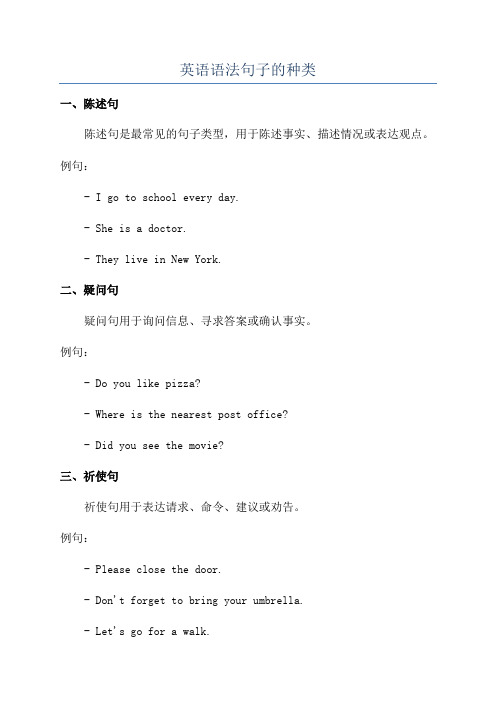
英语语法句子的种类一、陈述句陈述句是最常见的句子类型,用于陈述事实、描述情况或表达观点。
例句:- I go to school every day.- She is a doctor.- They live in New York.二、疑问句疑问句用于询问信息、寻求答案或确认事实。
例句:- Do you like pizza?- Where is the nearest post office?- Did you see the movie?三、祈使句祈使句用于表达请求、命令、建议或劝告。
例句:- Please close the door.- Don't forget to bring your umbrella.- Let's go for a walk.四、感叹句感叹句用于表达惊讶、赞美、失望或其他强烈的情感。
例句:- What a beautiful sunset!- How delicious the food is!- I can't believe we won the game!五、条件句条件句用于表达条件和结果之间的关系。
例句:- If it rains, we will stay indoors.- Unless you study hard, you will fail the exam.六、比较句比较句用于表示两个或多个事物之间的比较。
例句:- John is taller than Peter.- She sings better than him.- I prefer coffee to tea.七、否定句否定句用于否定陈述句中的内容。
例句:- I didn't see him at the party.- She doesn't like spicy food.- They haven't visited that museum before.。
英语语法之句子的种类
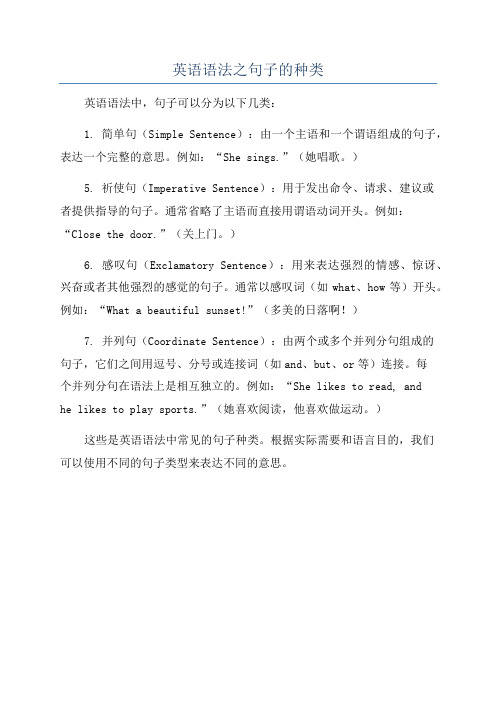
英语语法之句子的种类
英语语法中,句子可以分为以下几类:
1. 简单句(Simple Sentence):由一个主语和一个谓语组成的句子,表达一个完整的意思。
例如:“She sings.”(她唱歌。
)
5. 祈使句(Imperative Sentence):用于发出命令、请求、建议或
者提供指导的句子。
通常省略了主语而直接用谓语动词开头。
例如:“Close the door.”(关上门。
)
6. 感叹句(Exclamatory Sentence):用来表达强烈的情感、惊讶、兴奋或者其他强烈的感觉的句子。
通常以感叹词(如what、how等)开头。
例如:“What a beautiful sunset!”(多美的日落啊!)
7. 并列句(Coordinate Sentence):由两个或多个并列分句组成的
句子,它们之间用逗号、分号或连接词(如and、but、or等)连接。
每
个并列分句在语法上是相互独立的。
例如:“She likes to read, and
he likes to play sports.”(她喜欢阅读,他喜欢做运动。
)这些是英语语法中常见的句子种类。
根据实际需要和语言目的,我们
可以使用不同的句子类型来表达不同的意思。
英语语法之句子的种类

英语语法之句子的种类一、分类:按使用目的可分为陈述句、疑问句、祈使句和感叹句。
1. 陈述句:说明一个事实或陈述一种看法。
He gets up at six. 他六点钟起床。
(说明事实)I don't think so .我不这么认为。
(说明看法)2.疑问句:提出问题。
①一般疑问句:Can you finish the work in time?你能按时完成工作吗?②特殊疑问句:Where do you live?你住那儿?How do you know that? 你怎么知道那件事?③选择疑问句:Do you want tea or coffee?你是要茶还是要咖啡?④反意疑问句:He doesn't know her, does he?他不认识她,对不对?3. 祈使句:提出请求,建议或发出命令Sit down, please.请坐。
Don't be nervous!别紧张!4. 感叹句:表示说话人惊奇、喜悦、愤怒等情绪.1.陈述句:①肯定式:This is my sister .I like reading books at weekends .②否定式:A: "be+not" I am not a student.B:"do\does\did +not" He does not like playing basketball.C:"助动词\情态动词+not" I can not swim.D:用no、nothing、nobody表否定.I know nothing about it.2. 一般疑问句:①定义:用be动词、助动词或情态动词置于句首,可用“yes”或“no”来回答的问句。
②应答:用yes\no(或相当于“yes”或“no”的词)回答,并根据句首的be动词、情态动词或助动词作相应的回答。
--Is Mary a Japanese girl ? --Yes,she is.\No,she isn't.--Can you speak English? --Yes,I can .\No, I can't .--Do you like your teacher ? --Yes,I do.\No, I don't .③变形:如何将一个肯定的陈述句变为一般疑问句:A:看句中有无be动词,如果有be动词提到句首即可。
初中英语语法句子的种类

初中英语语法句子的种类英语是一门广泛使用的语言,在初中阶段,学生学习英语语法是非常重要的。
了解不同种类的句子结构和语法规则,可以帮助学生更好地理解和运用英语。
本文将介绍初中英语中常见的句子种类。
1. 简单句简单句是由一个主语和一个谓语构成的句子。
主语通常是一个名词或代词,而谓语则是一个动词或者动词短语。
例如:- I study English every day.- He is a good student.2. 并列句并列句由两个或多个简单句组成,它们通过连词(如and、but、or)相连。
两个并列句的结构和语法相似。
例如:- I like playing basketball, and my sister likes playing tennis.- He is not only smart but also hardworking.3. 复合句复合句由一个主句和一个或多个从句组成。
从句可以作为主句的一部分,承担名词、形容词或副词的功能。
从句通常由连词(如because、when、although)引导。
例如:- I like the movie, which was released last week.- He went to bed early because he was tired.4. 条件句条件句是由一个条件从句和一个主句构成的句子。
条件从句通常由if引导,表示某种条件或假设。
例如:- If it rains, we will stay at home.- She will be late unless she hurries up.5. 疑问句疑问句是用来提问的句子。
一般疑问句以助动词或be动词开头,也可以以疑问词开头。
例如:- Do you like pizza?- Where is the library?6. 感叹句感叹句用于表示惊讶、赞美、喜悦等情感。
感叹句通常以“What”或“How”开头。
初中语法句子种类讲解

句子的种类英语句子按照使用目的和交际功能,可分为四大类陈述句、疑问句、祈使句和感叹句.一.陈述句1、陈述句:说明一个事实或陈述一个看法,有肯定式和否定式,语序是主语在前,谓语在后。
2.掌握陈述句的肯定式和否定式的构成及用法。
e。
g。
We live in Tianjin。
(肯定句)我们住在天津。
We don’t live in Shanghai。
(否定句)我们不住在上海。
注意:(1)在一般现在时的肯定式中,主语是第三人称单数时,动词要改成第三人称单数形式.e.g。
John studies Chinese very well。
(2)若句中有be动词、情态动词或助动词,则分别在他们的后面加not.Sometimes you're supposed to come early. (变为否定句)(3)若句中有be动词、情态动词或助动词,要在行为动词(实义动词)前面加助动词do/does,did等与not的缩写形式,并注意这使得行为动词要用原型。
另外,还需将原句中some变成any,too改为either,already改为yet。
e。
g。
I don't like swimming. 我不喜欢游泳。
He doesn’t have lunch at home every day。
他每天不在家吃午饭。
They didn’t play football yesterday。
他们昨天没有踢足球.He did some work this morning。
(改为否定句)He didn't do any work this morning。
二.疑问句疑问句用来提出问题,句末用问号“?”。
常见的疑问句有:一般疑问句、特殊疑问句、选择疑问句和反意疑问句。
(一)一般疑问句:1.用来询问一件事,答案通常是yes或no,注意语序。
e。
g。
Do you often speak English at school ? 在学校你常讲英语吗?Yes, I do. /No,I don’t。
初中英语语法大全_ 句子种类

初中英语语法大全-句子的种类按照英语句子的使用目的和用途,句子可分为四类:陈述句(Declarative Sentence)、疑问句(Interrogative Sentence)、祈使句(Imperative Sentence)和感叹句(Exclamatory Sentence)。
陈述句包括肯定陈述句和否定陈述句。
疑问句有一般疑问句、特殊疑问句、选择疑问句和反意疑问句。
图解语法1. 陈述句说明一个事实或陈述一个人的看法,陈述句包括肯定陈述句和否定陈述句特别提示:肯定陈述句改成否定句或一般疑问句时,如句中有already,some,something,somebody等词,须分别改成yet,any,anything,anybody 等。
另外,也要注意,too改成either,both改成neither,all改成none等。
2. 疑问句3. 常用的特殊疑问句4. 特殊的反意疑问句①主句是祈使句时,“will you?”意为“请求”,“won’t you?”表示提醒对方注意。
例句:Look at the blackboard, will you / won’t you?Don’t be late again, will you?②感叹句后的反意疑问,用一般现在时态的否定形式例句:What fine weather, isn’t it?How beautifully she sings, doesn’t she?③陈述部分是“I am …”时,用“aren’t I?”而不用“am not I?”例句:I'm working now, aren’t I?④陈述部分主语是everything,nothing,anything或something 时,疑问句主语用it例句:Something is wrong with my radio, isn’t it?Nothing is difficult, is it?⑤陈述部分的主语是somebody,nobody,everybody,anybody,no one,none,neither 时,疑问句的主语用they例句:Everyone is here,aren’t they?No one knows about it,do they?⑥陈述部分的主语是:1) this或that时,问句的主语用it2) these或those时,问句主语用they3) there be句时,反意疑问句中用there例句:This is a plane, isn’t it?These are grapes, aren’t they?There was a hospital here, wasn’t there?⑦陈述部分的主语是one时,问句的主语可用one,也可用you (美语用he)例句:One should be ready to help others, shouldn’t one?⑧陈述句中有few,seldom,never hardly,not,rarely,no,nobody,too…to等时,疑问句部分用肯定结构;如由前后缀构成否定词,疑问句部分仍用否定结构例句:He is never late for school, is he?You got nothing from him, did you?It is useless, isn’t it?⑨陈述部分主语是从句、不定式(短语)、动词-ing形式时,疑问句的主语用it例句:What you need is more important,isn’t it?⑩陈述部分由think,believe,suppose,imagine等引导的宾语从句:1) 主语是第一人称时,问句与从句的主谓语一致2) 主语是其他人称,问句与主句的主谓语一致例句:I think he will come, won’t he?I don’t think he can pass the exam, can he?He believed you had seen her before, didn’t he?? have是实义动词时,疑问句用助动词do,does,did;have 是助动词,则不然例如:They had a meeting just now, didn’t they?She’s been to many places of interest, hasn’t she?? 陈述部分有have /has /had to 时,疑问句要用助动词的否定形式例句:You have to water the vegetables now, don’t you?? 陈述部分有had better时,疑问句中用hadn’t刘局:We had better go to school at once, hadn’t we?? 陈述部分有must:1) 作“一定;必须”解释时,疑问句用mustn’t或needn’t;2) 表示推测,作“一定是;必定”解释时,疑问句需根据其后的动词原形选用相应的形式;3) 对过去动作推测时,问句的助动词用did或have;4) 对过去的状态推测时,问句的be用was例句:He must work hard at physics, mustn’t he?You must go to Guangzhou, needn’t you?You mustn’t smoke here, must you?Tom must be at home, isn’t he?She must have finished her work, hasn’t/didn’t she?He must have been a policeman, wasn’t he?? 陈述部分有ought to,used to,疑问句要用shouldn’t,usedn’t / didn’t例句:Jill used to be a teacher, usedn’t / didn’t she?? 陈述句部分是复合句时,疑问句的主语和助动词要与主句一致例句:He was reading when the teacher came in, wasn’t he?特别提示:反意疑问句是“否定陈述句+肯定问句”时,如回答内容是肯定的,用“Yes+肯定结构”,反之,用“No+否定结构”。
初中英语:英语语法大全之句子的种类
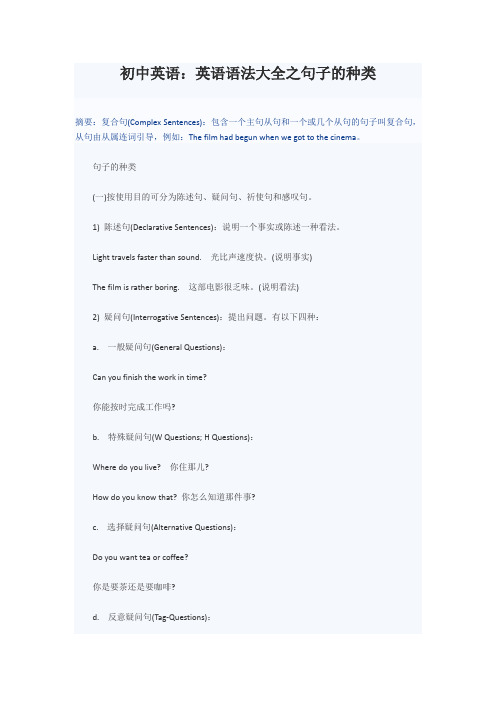
初中英语:英语语法大全之句子的种类摘要:复合句(Complex Sentences):包含一个主句从句和一个或几个从句的句子叫复合句,从句由从属连词引导,例如:The film had begun when we got to the cinema。
句子的种类(一)按使用目的可分为陈述句、疑问句、祈使句和感叹句。
1) 陈述句(Declarative Sentences):说明一个事实或陈述一种看法。
Light travels faster than sound.光比声速度快。
(说明事实)The film is rather boring.这部电影很乏味。
(说明看法)2) 疑问句(Interrogative Sentences):提出问题。
有以下四种:a.一般疑问句(General Questions):Can you finish the work in time?你能按时完成工作吗?b.特殊疑问句(W Questions; H Questions):Where do you live?你住那儿?How do you know that? 你怎么知道那件事?c.选择疑问句(Alternative Questions):Do you want tea or coffee?你是要茶还是要咖啡?d.反意疑问句(Tag-Questions):He doesn't know her, does he?他不认识她,对不对?3) 祈使句(Imperative Sentences):提出请求,建议或发出命令,例如:Sit down, please.请坐。
Don't be nervous!别紧张!4) 感叹句(Exclamatory Sentences):表示说话人惊奇、喜悦、愤怒等情绪,例如:What good news it is!多好的消息啊!(二)句子按其结构可以分为以下三类:1) 简单句(Simple Sentences):只包含一个主谓结构句子叫简单句,例如:She is fond of collecting stamps.她喜欢集邮。
英语语法中句子的种类
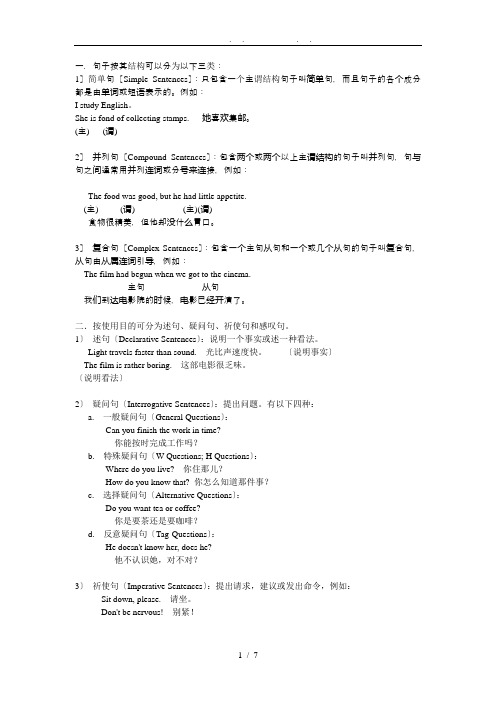
一.句子按其结构可以分为以下三类:1〕简单句〔Simple Sentences〕:只包含一个主谓结构句子叫简单句,而且句子的各个成分都是由单词或短语表示的。
例如:I study English。
She is fond of collecting stamps.她喜欢集邮。
(主)(谓)2〕并列句〔Compound Sentences〕:包含两个或两个以上主谓结构的句子叫并列句,句与句之间通常用并列连词或分号来连接,例如:The food was good, but he had little appetite.(主)(谓)(主)(谓)食物很精美,但他却没什么胃口。
3〕复合句〔Complex Sentences〕:包含一个主句从句和一个或几个从句的句子叫复合句,从句由从属连词引导,例如:The film had begun when we got to the cinema.主句从句我们到达电影院的时候,电影已经开演了。
二.按使用目的可分为述句、疑问句、祈使句和感叹句。
1〕述句〔Declarative Sentences〕:说明一个事实或述一种看法。
Light travels faster than sound.光比声速度快。
〔说明事实〕The film is rather boring.这部电影很乏味。
〔说明看法〕2〕疑问句〔Interrogative Sentences〕:提出问题。
有以下四种:a.一般疑问句〔General Questions〕:Can you finish the work in time?你能按时完成工作吗?b.特殊疑问句〔W Questions; H Questions〕:Where do you live?你住那儿?How do you know that? 你怎么知道那件事?c.选择疑问句〔Alternative Questions〕:Do you want tea or coffee?你是要茶还是要咖啡?d.反意疑问句〔Tag-Questions〕:He doesn't know her, does he?他不认识她,对不对?3〕祈使句〔Imperative Sentences〕:提出请求,建议或发出命令,例如:Sit down, please.请坐。
初中英语语法之-句子的种类

考点一 陈述句和疑问句 一、陈述句
用来陈述一件事实或表达说话者看法的句子叫作陈述句, 句末用句号表示句子的陈述结束。陈述句分为肯定句和否定句。
二、疑问句 用来表示提问的句子叫作疑问句,句末用问号。疑问句包
括一般疑问句、特殊疑问句、选择疑问句和反意疑问句四种。 (一)一般疑问句
(二)特殊疑问句
也叫附加疑问句。反意疑问句前一部分是陈述句,后一部分是 简短问句。陈述部分用逗号结尾,反问部分用问号结尾。例如:
It’s a nice day, isn’t it? 天气不错,不是吗?
1. 基本结构:前肯后否;前否后肯。例如: ①We have talked件事了,不是吗? ②Mr. Smith isn’t at home, is he? 史密斯先生不在家,是吗?
考点二 感叹句
【巧学妙记】感叹句,并不难,what或how摆在前。 强调名词用what,其余how很简单。 名词若是可数单,前带冠词a或an。 主语谓语放在后,省略也是很常见。
考点三 祈使句
祈使句表达说话人对对方的劝告、叮嘱、建议、请求或命 令等。主语you通常省略,谓语动词用原形,句末用感叹号或 句号。表达请求或劝告时,祈使句句末或句首可以加上please 表示委婉的语气。
1. there be与have的区别 (1)There be结构表示“某地有某人/物”,强调客观存在。 (2)have(has, had)表示“(某人)拥有某物”,强调所属关系。 例如: Mr. Bush has two daughters. 布什先生有两个女儿。
2. There be句型的句式变化 (1)对There be句型中的主语提问用:What’s + 地点状语/时间 状语? 例如: There are many birds in the forests. 树林里有许多鸟。 →What’s in the forests? 树林里有什么?
初中英语语法大全句子种类

初中英语语法大全句子种类集团标准化工作小组 [Q8QX9QT-X8QQB8Q8-NQ8QJ8-M8QMN]初中英语语法大全-句子的种类按照英语句子的使用目的和用途,句子可分为四类:陈述句(Declarative Sentence)、疑问句(Interrogative Sentence)、祈使句(Imperative Sentence)和感叹句(Exclamatory Sentence)。
陈述句包括肯定陈述句和否定陈述句。
疑问句有一般疑问句、特殊疑问句、选择疑问句和反意疑问句。
图解语法1. 陈述句说明一个事实或陈述一个人的看法,陈述句包括肯定陈述句和否定陈述句特别提示:肯定陈述句改成否定句或一般疑问句时,如句中有already,some,something,somebody等词,须分别改成yet,any,anything,anybody等。
另外,也要注意,too改成either,both改成neither,all改成none 等。
2. 疑问句3. 常用的特殊疑问句4. 特殊的反意疑问句①主句是祈使句时,“will you”意为“请求”,“won’t you”表示提醒对方注意。
例句:Look at the blackboard, will you / won’t youDon’t be late again, will you②感叹句后的反意疑问,用一般现在时态的否定形式例句:What fine weather, isn’t itHow beautifully she sings, doesn’t she③陈述部分是“I am …”时,用“aren’t I”而不用“am not I”例句:I'm working now, aren’t I④陈述部分主语是everything,nothing,anything或something 时,疑问句主语用it例句:Something is wrong with my radio, isn’t itNothing is difficult, is it⑤陈述部分的主语是somebody, nobody, everybody, anybody, no one, none, neither 时,疑问句的主语用they例句:Everyone is here, aren’t theyNo one knows about it, do they⑥陈述部分的主语是:1) this或that时,问句的主语用it2) these或those时,问句主语用they3) there be句时,反意疑问句中用there例句:This is a plane, isn’t itThese are grapes, aren’t theyThere was a hospital here, wasn’t there⑦陈述部分的主语是one时,问句的主语可用one,也可用you (美语用he)例句:One should be ready to help others, shouldn’t one⑧陈述句中有few, seldom, never hardly,not,rarely,no,nobody,too…to等时,疑问句部分用肯定结构;如由前后缀构成否定词,疑问句部分仍用否定结构例句:He is never late for school, is heYou got nothing from him, did youIt is useless, isn’t it⑨陈述部分主语是从句、不定式(短语)、动词-ing形式时,疑问句的主语用it例句:What you need is more important, isn’t it⑩陈述部分由think, believe, suppose, imagine等引导的宾语从句:1) 主语是第一人称时,问句与从句的主谓语一致2) 主语是其他人称,问句与主句的主谓语一致例句:I think he will come, won’t heI don’t think he can pass the exam, can heHe believed you had seen her before, didn’t hehave是实义动词时,疑问句用助动词do,does,did;have 是助动词,则不然例如:They had a meeting just now, didn’t theyShe’s been to many places of interest, hasn’t she陈述部分有have /has /had to 时,疑问句要用助动词的否定形式例句:You have to water the vegetables now, don’t you陈述部分有had better时,疑问句中用hadn’t刘局:We had better go to school at once, hadn’t we陈述部分有must:1) 作“一定;必须”解释时,疑问句用mustn’t或needn’t;2) 表示推测,作“一定是;必定”解释时,疑问句需根据其后的动词原形选用相应的形式;3) 对过去动作推测时,问句的助动词用did或have;4) 对过去的状态推测时,问句的be用was例句:He must work hard at physics, mustn’t heYou must go to Guangzhou, needn’t youYou mustn’t smoke here, must youTom must be at home, isn’t heShe must have finished her work, hasn’t/didn’t sheHe must have been a policeman, wasn’t he陈述部分有ought to,used to,疑问句要用 shouldn’t,usedn’t / didn’t例句:Jill used to be a teacher, usedn’t / didn’t she陈述句部分是复合句时,疑问句的主语和助动词要与主句一致例句:He was reading when the teacher came in, wasn’t he特别提示:反意疑问句是“否定陈述句+肯定问句”时,如回答内容是肯定的,用“Yes+肯定结构”,反之,用“No+否定结构”。
初中语法句子种类讲解完整版

初中语法句子种类讲解完整版1. 陈述句(Declarative Sentence):陈述句是用来陈述事实或表达其中一种观点的句子。
陈述句通常以陈述句调升降或陈述句调降提。
例如:- The sun rises in the east.(太阳东升。
)- I like playing basketball.(我喜欢打篮球。
)2. 疑问句(Interrogative Sentence):疑问句是用来提出问题的句子。
疑问句通常以疑问句调升提或疑问句调降提。
例如:- Did you finish your homework?(你完成作业了吗?)- What is your name?(你叫什么名字?)3. 祈使句(Imperative Sentence):祈使句是用来表示请求、命令或建议的句子。
祈使句的主语通常是第二人称(你)或省略。
例如:- Please close the door.(请关上门。
)- Let's go to the park.(让我们去公园吧。
4. 感叹句(Exclamatory Sentence):感叹句是用来表达感叹、惊讶或强调的句子。
感叹句通常以感叹句调升降或感叹句调降提。
例如:- What a beautiful flower!(多么美丽的花啊!)- How brave they are!(他们多么勇敢啊!)除了这些基本的句子种类外,还有一些复合句子的种类,如复合句、并列句、从句等。
但是在初中语法中,主要讨论的是简单句。
这些句子种类的使用取决于不同的语境和表达目的,要根据具体情况选择恰当的句子类型。
初中英语语法之句子的种类
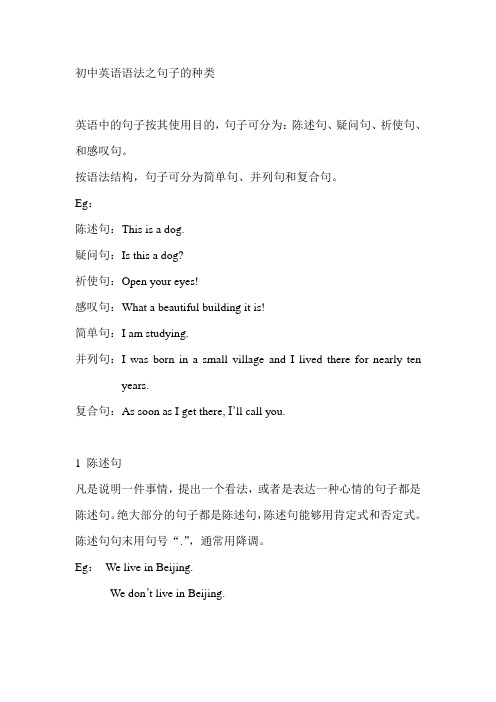
初中英语语法之句子的种类英语中的句子按其使用目的,句子可分为:陈述句、疑问句、祈使句、和感叹句。
按语法结构,句子可分为简单句、并列句和复合句。
Eg:陈述句:This is a dog.疑问句:Is this a dog?祈使句:Open your eyes!感叹句:What a beautiful building it is!简单句:I am studying.并列句:I was born in a small village and I lived there for nearly ten years.复合句:As soon as I get there, I’ll call you.1 陈述句凡是说明一件事情,提出一个看法,或者是表达一种心情的句子都是陈述句。
绝大部分的句子都是陈述句,陈述句能够用肯定式和否定式。
陈述句句末用句号“.”,通常用降调。
Eg:We live in Beijing.We don’t live in Beijing.(1) be 动词、一般动词(实义动词)、情态动词的否定句I am not a student.I don’t know him.He can’t speak English.01. be 动词的否定句句型:主语+ be动词+ not + …I wasn’t good at English.They weren’t at home yesterday.He isn’t my cousin.实行时和被动语态都有be 动词,它们的否定句与be动词的否定句同形。
Eg:They aren’t cleaning the room.The child was not looked after by anybody.将来时(will,shall)、完成时及情态动词的被动语态不能用be动词否定句型。
They will not be sent to the front.They will be not sent to the front.×02 情态动词的否定句句型:主语+情态动词+ not + 动词原形Eg:I can’t do it myself.You mustn’t take the books out.You must not go there alone.03 一般动词的否定句句型:主语+ do/does/did + not + 动词原形Eg:They didn’t live in Shanghai.He doesn’t do his homework every day.They didn’t have the class-meeting yesterday afternoon.04现在完成时的否定句句型:主语+ have/has+ not + 动词的过去分词+……I haven’t finished reading the book yet.He hasn’t had his breakfast yet.05过去完成时的否定句句型:主语+ had+ not + 动词的过去分词+……He had n’t finished reading the book by the end of last month.(2).否定结构应注意事项01 使用not 的部分否定含有not的句子,如果使用了very, always以及不定代词all, both, every 及every的复合词,则表示部分否定。
- 1、下载文档前请自行甄别文档内容的完整性,平台不提供额外的编辑、内容补充、找答案等附加服务。
- 2、"仅部分预览"的文档,不可在线预览部分如存在完整性等问题,可反馈申请退款(可完整预览的文档不适用该条件!)。
- 3、如文档侵犯您的权益,请联系客服反馈,我们会尽快为您处理(人工客服工作时间:9:00-18:30)。
初中英语语法大全之句子的种类
2011-09-24 15:37:42 来源:本站原创进入论坛
句子的种类
(一)按使用目的可分为陈述句、疑问句、祈使句和感叹句。
1)陈述句(Declarative Sentences):说明一个事实或陈述一种看法。
Light travels faster than sound。
光比声速度快。
(说明事实)
The film is rather boring。
这部电影很乏味。
(说明看法)
2)疑问句(Interrogative Sentences):提出问题。
有以下四种:
a.一般疑问句(General Questions):
Can you finish the work in time?
你能按时完成工作吗?
b.特殊疑问句(W Questions;H Questions):
Where do you live?你住那儿?
How do you know that?你怎么知道那件事?
c.选择疑问句(Alternative Questions):
Do you want tea or coffee?
你是要茶还是要咖啡?
d.反意疑问句(Tag-Questions):
He doesn‘t know her,does he?
他不认识她,对不对?
3)祈使句(Imperative Sentences):提出请求,建议或发出命令,例如:
Sit down,please。
请坐。
Don’t be nervous!别紧张!
4)感叹句(Exclamatory Sentences):表示说话人惊奇、喜悦、愤怒等情绪,例如:
What good news it is!多好的消息啊!
(二)句子按其结构可以分为以下三类:
1)简单句(Simple Sentences):只包含一个主谓结构句子叫简单句,例如:
She is fond of collecting stamps。
她喜欢集邮。
(主)(谓)
2)并列句(Compound Sentences):包含两个或两个以上主谓结构的句子叫并列句,句与句之间通常用并列连词或分号来连接,例如:
The food was good,but he had little appetite。
(主)(谓)(主)(谓)
食物很精美,但他却没什么胃口。
3)复合句(Complex Sentences):包含一个主句从句和一个或几个从句的句子叫复合句,从句由从属连词引导,例如:
The film had begun when we got to the cinema。
主句从句
我们到达电影院的时候,电影已经开演了。
(三)基本句型(BasicSentencePatterns):英语中千变万化的句子归根结底都是由以下五种基本句型组合、扩展、变化而来的:
1)主+动(SV)例如:
I work。
我工作。
2)主+动+表(SVP)例如:
John is busy。
约翰忙。
3)主+动+宾(SVO)例如:
She studies English。
她学英语。
4)主+动+宾+补(SVOC)例如:
Time would prove me right。
时间会证明我是对的。
5)主+动+间宾+直宾(SVOiOd)例如:
My mother made me a new dress。
我母亲给我做了一件新衣裳。
